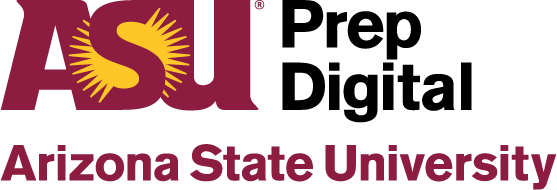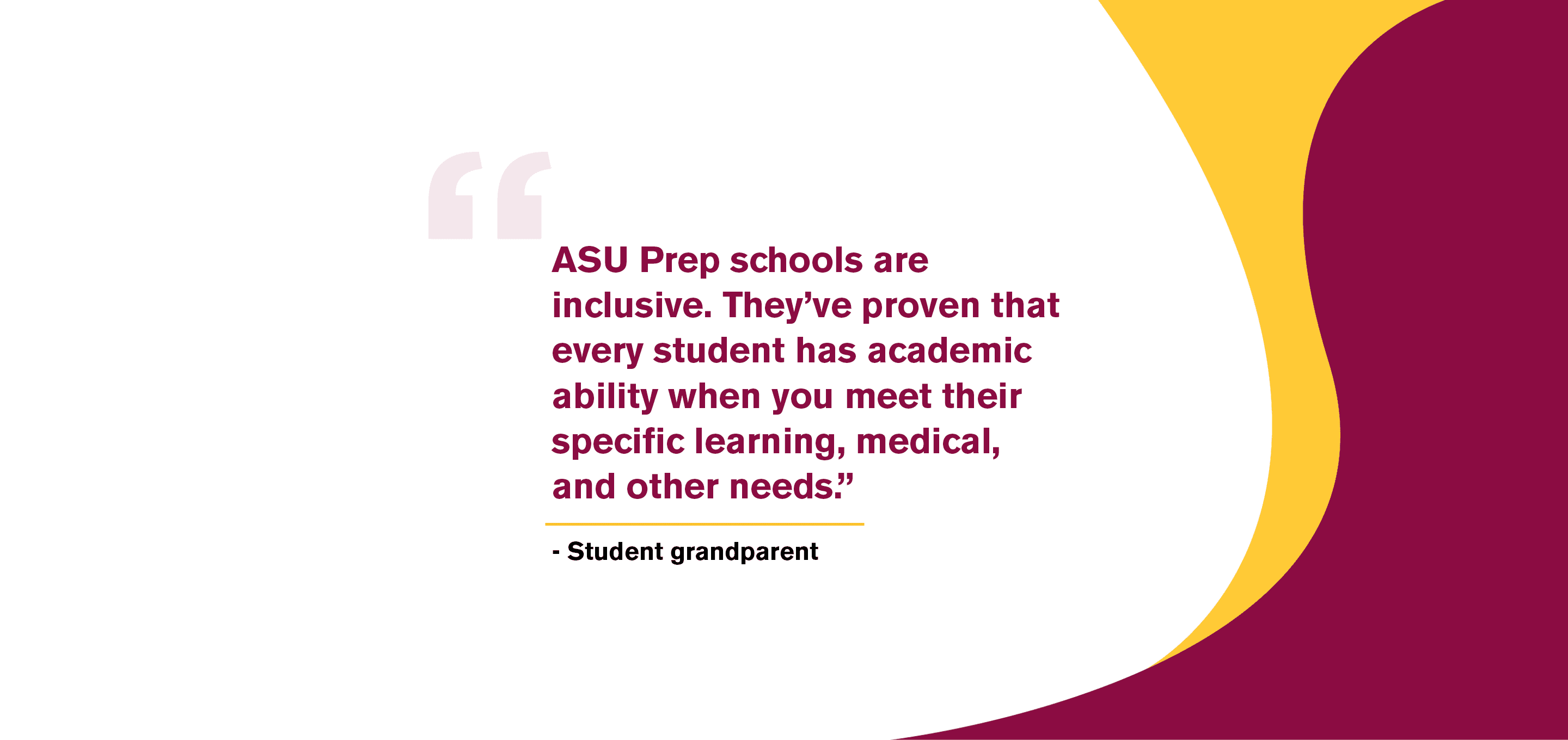We often get parents who write to us or tell us how ASU has benefitted their child. Last month, we were honored to have a grandparent of one of our ASU Prep Poly High School seniors speak at an assembly. The speech has been lightly edited for length.
“Thirteen years ago, I was researching schools for my granddaughter who would be starting kindergarten in the fall. I knew that many Arizona high school graduates weren’t college ready, and I was taking this school choice thing very seriously. I learned that the President of ASU, Michael Crow, had the idea to start charter schools aligned to college campuses where the best practices known for grade school and high school could be implemented and perfected, resulting in students who could thrive and graduate college ready. It sounded like a good idea to me, and our family chose ASU Prep at the Polytechnic campus (though at the time it was in a nearby strip mall).
Fast forward 13 years later. My granddaughter, Jordan, is a high school senior on track to graduate in May.
“From our family’s perspective, Michael Crow’s vision has been fully realized. Jordan is undoubtedly college ready and already has college credits.”
She’s been accepted to four prestigious, private universities and one public entity. All five have offered her significant merit scholarships and we’re more than excited about her very bright future.
There are so many things I want to share about this school and so many reasons why I want to share it. My main reason is to express my gratitude. Next, I hope I will influence potential donors or grant makers to invest in this school or any ASU Prep school. We did, and it was well worth it. Also, if there are any prospective families here, maybe my remarks can help you choose.
Academic and Enrichment Opportunities
Now, I could talk about academic characteristics: STEM learning, project-based, blended learning, individualized, accelerated learning opportunities, internships—but there’s more than excellent academics. There’s character, culture, inclusion, growth mindset, college-bound culture, be kind, be smart, work hard—a safe, motivating, and nurturing environment for learning.
And then there’s the enrichment opportunities, both academic and cultural like the violin lessons Jordan took after school in her primary grades, Color Guard, service clubs like NJHS, NHS, and Key Club, student ambassadors, news junkies, sports and more.
I want to acknowledge some important people. It did take more than Michael Crow’s vision to create this successful school and the other ASU Prep Schools. Beatriz Rendon, Vice President of Strategic Initiatives for ASU, who graciously invited me here this afternoon, was the founding CEO for the ASU Preparatory Schools and built the network of high-achieving schools that exist today. Claudia Mendoza, founding principal, has been an exceptional leader for ASU Prep Poly for as long as we’ve been involved. Mrs. Kochis has been an impactful leader the entire time as well, in teaching and administrative roles. I’d like to recognize Julie Young, the current Managing Director, Carrie Larson, Chief Academic Officer, and Stephen Rothkopf, the new 7-12 principal here at Poly High School.
Now for the stories. Jordan and I talked and she was open to her experiences being shared with all of you. Charter schools are sometimes criticized for creaming the crop, that is for nurturing students with the highest potential while counseling families of students who need additional support to find a better-fit school.
“ASU Prep schools are inclusive. They’ve proven that every student has academic ability when you meet their specific learning, medical, and other needs.”
Jordan has benefitted from learning side-by-side with students who needed a one-on-one assistant, students who were working several grades ahead, multi-grade classrooms, and students at her same level.
Benefits of Inclusive Learning
In the beginning of second grade, at 7 years old, Jordan was diagnosed with T1D, very different from T2D, a life-threatening, incurable, but mostly invisible, auto-immune disease. The school’s response was total accommodation. Every year from second grade to ninth grade, Mrs. Mendoza facilitated a meeting of all Jordan’s teachers so that I could share basic information about Jordan’s diagnosis, what she needed, and the signs of a dangerous blood sugar level. Teachers kept juice boxes in their classes in case her blood sugar went too low, graciously accepted all the times throughout the day that her instruction was interrupted so she could go to the health office to check her blood sugar and facilitated make-up work the couple of times Jordan had to be hospitalized. The school made sure she never walked alone to the health office knowing if her blood sugar fell too low, she could pass out.
Like some other ASU Prep students, Jordan has a 504 plan that’s revisited every year and supports her academic success while accommodating her health condition. Mrs. G, the health assistant, is our heroine in this story. Her meticulous care and recordkeeping were essential to Jordan’s well-being, and so her ability to learn.
Hands-on assignments brought learning to life
On the academic front, Jordan told me how important the project-based learning and group assignments were, sharing that listening to information was okay, but a hands-on assignment brought the learning to life and made it meaningful. When the assignment was a group project and students processed the information together, the content was even better understood.
I personally observed this myself at Science Camp, but I’ll use Jordan’s Journalism class as a more recent example. The journalism class doesn’t simply learn about journalism and write a few different types of articles. The journalism class produces the school yearbook. Students have relevant roles like photographer and editor, responsibility for specific pages, layout tasks and proofing. Producing a significant publication that will be seen by peers, parents, teachers, and administrators (some will save for a lifetime) offers a far more comprehensive, and accountable journalism learning experience. It’s also one of many examples of equipping students with cooperation and collaboration competencies they’ll need everywhere they go in life.
STEM learning is even incorporated in producing the yearbook when you realize the technology involved in photography and in software and websites specific to graphic design and layout that wouldn’t have been used in a writing-only kind of journalism class.
Now I’d like to recognize an outstanding teacher, Mr. Blair Barnes. Mr. Barnes is the World Language Teacher (teaching both Spanish and French), Advisor to the News Junkies Club, and Boys Soccer Coach. He taught Jordan’s Spanish and Journalism classes. Mr. Barnes sets expectations that motivate students to stretch their academic abilities. He recognizes academic excellence, listens to students’ ideas, helps them develop critical thinking skills, and supports students in their educational goals. Mr. Barnes is the kind of educator every family wants for their students and I’m grateful Jordan had him for a teacher.
If I named every great teacher Jordan has had here, I could go on and on. We’ve never had a bad teacher. Thank you all for not only teaching Jordan, but for also taking her under your wings. I also want to express heartfelt gratitude to Katie Dukes, an accessible and attentive counselor, and again to Mrs. G, the health assistant. “
“We’ve all heard the parable that it takes a village to raise a child—ASU Prep Poly has been an impactful and significant part of our village.”
Thank you for sharing your granddaughter’s journey with us. We are happy to have you as part of the ASU Prep family, and we are excited about her very bright future too!
It means a lot when we hear how we’re helping students succeed. We’d love to hear from you. Share your story with us at Elogan4@asu.edu.


